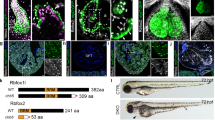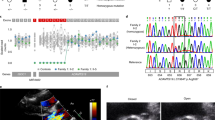Abstract
Tricuspid atresia (TA) is a common form of congenital heart disease, accounting for 1–3% of congenital cardiac disorders1. TA is characterized by the congenital agenesis of the tricuspid valve connecting the right atrium to the right ventricle and both an atrial septal defect (ASD) and a ventricular septal defect2 (VSD). Some patients also have pulmonic stenosis, persistence of a left-sided superior vena cava or transposition of the great arteries. Most cases of TA are sporadic, but familial occurrences with disease in multiple siblings have been reported3,4,5. Gata4 is a zinc-finger transcription factor with a role in early cardiac development. Gata4-deficient mice fail to form a ventral heart tube and die of circulatory failure at embryonic day (E) 8.5 (refs 6,7). Zfpm2 (also known as Fog-2) is a multi-zinc-finger protein that is co-expressed with Gata4 in the developing heart beginning at E8.5 (refs 8–10). Zfpm2 interacts specifically with the N-terminal zinc finger of Gata4 and represses Gata4-dependent transcription8,9,10. Here we use targeted mutagenesis to explore the role of Zfpm2 in normal cardiac development. Zfpm2-deficient mice died of congestive heart failure at E13 with a syndrome of tricuspid atresia that includes an absent tricuspid valve, a large ASD, a VSD, an elongated left ventricular outflow tract, rightward displacement of the aortic valve and pulmonic stenosis. These mice also display hypoplasia of the compact zone of the left ventricle. Our findings indicate the importance of Zfpm2 in the normal looping and septation of the heart and suggest a genetic basis for the syndrome of tricuspid atresia.
This is a preview of subscription content, access via your institution
Access options
Subscribe to this journal
Receive 12 print issues and online access
$209.00 per year
only $17.42 per issue
Buy this article
- Purchase on Springer Link
- Instant access to full article PDF
Prices may be subject to local taxes which are calculated during checkout




Similar content being viewed by others
References
Sade, R.M. & Fyfe, D.A. Tricuspid atresia: current concepts in diagnosis and treatment. Pediatr. Clin. North Am. 37, 151–169 (1990).
Rao, P.S. A unified classification for tricuspid atresia. Am. Heart J. 99, 799–804 (1980).
Lin, A.E. & Rosti, L. Tricuspid atresia in sibs. J. Med. Genet. 35, 1055–1056 (1998).
Kumar, A., Victorica, B.E., Gessner, I.H. & Alexander, J.A. Tricuspid atresia and annular hypoplasia: report of a familial occurrence. Pediatr. Cardiol. 15, 201–203 (1994).
Bonnet, D. et al. Tricuspid atresia and conotruncal malformations in five families. J. Med. Genet. 36, 349–350 (1999).
Molkentin, J.D., Lin, Q., Duncan, S.A. & Olson, E.N. Requirement of the transcription factor Gata4 for heart tube formation and ventral morphogenesis. Genes Dev. 11, 1061–1072 (1997).
Kuo, C.T. et al. Gata4 transcription factor is required for ventral morphogenesis and heart tube formation. Genes Dev. 11, 1048–1060 (1997).
Lu, J.R. et al. FOG-2, a heart- and brain-enriched cofactor for GATA transcription factors. Mol. Cell. Biol. 19, 4495–4502 (1999).
Svensson, E.C., Tufts, R.L., Polk, C.E. & Leiden, J.M. Molecular cloning of FOG-2: a modulator of transcription factor GATA-4 in cardiomyocytes. Proc. Natl Acad. Sci. USA 96, 956–961 (1999).
Tevosian, S.G. et al. FOG-2: a novel GATA-family cofactor related to multitype zinc-finger proteins Friend of GATA-1 and U-shaped. Proc. Natl Acad. Sci. USA 96, 950–955 (1999).
Kuo, C.T. et al. The LKLF transcription factor is required for normal tunica media formation and blood vessel stabilization during murine embryogenesis. Genes Dev. 11, 2996–3006 (1997).
Svensson, E., Huggins, G., Dardik, F., Polk, C. & Leiden, J. A functionally conserved N-terminal domain of the friend of GATA 2 (FOG-2) protein represses Gata4-dependent transcription. J. Biol. Chem. (in press).
Lamers, W.H., Viragh, S., Wessels, A., Moorman, A.F. & Anderson, R.H. Formation of the tricuspid valve in the human heart. Circulation 91, 111–121 (1995).
Lyons, I. et al. Myogenic and morphogenetic defects in the heart tubes of murine embryos lacking the homeo box gene Nkx2-5. Genes Dev. 9, 1654–1666 (1995).
Biben, C. & Harvey, R.P. Homeodomain factor Nkx2-5 controls left/right asymmetric expression of bHLH gene eHand during murine heart development. Genes Dev. 11, 1357–1369 (1997).
Srivastava, D. et al. Regulation of cardiac mesodermal and neural crest development by the bHLH transcription factor, dHAND. Nature Genet. 16, 154–160 (1997).
Ranger, A.M. et al. The transcription factor NF-ATc is essential for cardiac valve formation. Nature 392, 186–190 (1998).
de la Pompa, J.L. et al. Role of the NF-ATc transcription factor in morphogenesis of cardiac valves and septum. Nature 392, 182–186 (1998).
Webb, S., Brown, N.A. & Anderson, R.H. Formation of the atrioventricular septal structures in the normal mouse. Circulation Res. 82, 645–656 (1998).
Webb, S., Anderson, R.H., Lamers, W.H. & Brown, N.A. Mechanisms of deficient cardiac septation in the mouse with trisomy 16. Circ. Res. 84, 897–905 (1999).
Lee, R.Y., Luo, J., Evans, R.M., Giguere, V. & Sucov, H.M. Compartment-selective sensitivity of cardiovascular morphogenesis to combinations of retinoic acid receptor gene mutations. Circ. Res. 80, 757–764 (1997).
Anderson, R.H., Webb, S. & Brown, N.A. The mouse with trisomy 16 as a model of human hearts with common atrioventricular junction. Cardiovasc. Res. 39, 155–164 (1998).
Webb, S., Brown, N.A. & Anderson, R.H. Cardiac morphology at late fetal stages in the mouse with trisomy 16: consequences for different formation of the atrioventricular junction when compared to humans with trisomy 21. Cardiovasc. Res. 34, 515–524 (1997).
Gelb, B.D., Towbin, J.A., McCabe, E.R. & Sujansky, E. San Luis Valley recombinant chromosome 8 and tetralogy of Fallot: a review of chromosome 8 anomalies and congenital heart disease. Am. J. Med. Genet. 40, 471–476 (1991).
Sujansky, E. et al. Natural history of the recombinant (8) syndrome. Am. J. Med. Genet. 47, 512–525 (1993).
Tybulewicz, V.L., Crawford, C.E., Jackson, P.K., Bronson, R.T. & Mulligan, R.C. Neonatal lethality and lymphopenia in mice with a homozygous disruption of the c-abl proto-oncogene. Cell 65, 1153–1163 (1991).
Soudais, C. et al. Targeted mutagenesis of the transcription factor GATA-4 gene in mouse embryonic stem cells disrupts visceral endoderm differentiation in vitro. Development 121, 3877–3888 (1995).
Morrisey, E.E., Ip, H.S., Tang, Z., Lu, M.M. & Parmacek, M.S. GATA-5: a transcriptional activator expressed in a novel temporally and spatially-restricted pattern during embryonic development. Dev. Biol. 183, 21–36 (1997).
Acknowledgements
We thank T. Lis for help with the preparation of illustrations; D. Zhang for help with the preparation of histological sections; and R. Van Praagh for help with the review of histological sections from Zfpm2−/− mice. This work was supported in part by grants from the NIH to J.M.L. (HL 54592) and G.S.H. (HL 03667).
Author information
Authors and Affiliations
Corresponding author
Rights and permissions
About this article
Cite this article
Svensson, E., Huggins, G., Lin, H. et al. A syndrome of tricuspid atresia in mice with a targeted mutation of the gene encoding Fog-2. Nat Genet 25, 353–356 (2000). https://doi.org/10.1038/77146
Received:
Accepted:
Issue Date:
DOI: https://doi.org/10.1038/77146
This article is cited by
-
Induced Pluripotent Stem Cell–Based Modeling of Single-Ventricle Congenital Heart Diseases
Current Cardiology Reports (2023)
-
Genomic frontiers in congenital heart disease
Nature Reviews Cardiology (2022)
-
Delving into the Molecular World of Single Ventricle Congenital Heart Disease
Current Cardiology Reports (2022)
-
Identification of ZFPM2 mutations in sporadic conotruncal heart defect patients
Molecular Genetics and Genomics (2018)
-
CpG island shore methylation of ZFPM2 is identified in tetralogy of fallot samples
Pediatric Research (2016)



